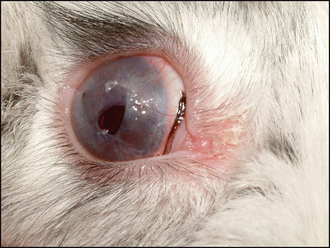14 Aberrant conjunctival overgrowth in rabbits
CLINICAL EXAMINATION
General clinical examination is unremarkable – the rabbit is normally in good body condition with no dental problems. On ophthalmic examination the rabbit is normally visual (although menace responses are not always present in rabbits). No ocular discharge is present and the eye is open and comfortable. A pink, fleshy, vascular membrane is present over the cornea through a full 360 degrees extending centrally. It can extend only a couple of millimetres, but might cover virtually the whole of the cornea such that only a small central hole remains (see Figure 14.2). Intraocular examination, if possible, is normal. Rabbits have a merangiotic retina – a horizontally oval optic disc with vessels radiating from either end (laterally and medially) – and this is most easily examined by looking up at the rabbit from below, while its head is held over the end of the consulting table. No corneal ulceration is present. If a drop of topical anaesthetic is placed in the affected eye, the pink membrane can be lightly touched with a cotton bud and can be gently moved over the corneal surface – it is not attached centrally.




